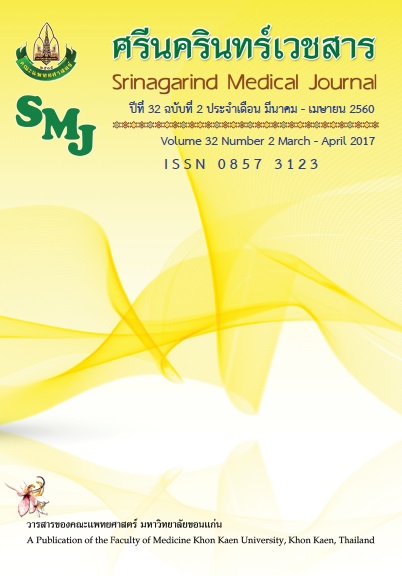Factors Associated with Bacterial Septicemia among Patients in Intensive Care Unit, Roi Et Hospital, Roi Et Province
Keywords:
Nosocomial infection, Risk factor, Bloodstream infection, Intensive Care Unit, โรคติดเชื้อฉวยโอกาส, ปัจจัยเสี่ยง, ติดเชื้อในกระแสเลือด, หอผู้ป่วยวิกฤตAbstract
Background and Objective : Nosocomial blood stream infection is a major problem in hospitals worldwide including Thailand. Infected patients are difficult to treat and have high risk of death. This study aimed to investigate the factors associated with nosocomial bloodstream infection among patients in Intensive Care Unit.
Methods: A hospital-based case-control study (case: control = 1:1) was conducted. All data were collected from medical records of patients in the Intensive Care Unit in Roi Et hospital, Roi Et province between January 1, 2015 and December 31, 2015. The variables of interest were general informations and histories of treatment. Data analyses were descriptive statistics, univariate analysis and multivariate analysis by multiple logistic regressions.
Results: From 91 cases, most of them were males, 52.7 % with the mean age 57.6 +18.9 years whereas 91 controls most of them were males, 56.0% and mean age 55.2 +15.9 years. The top three causes of bacterial septicemias were 28.6% Staphylococcus coagulase negative, 13.2 % P. aeruginosa and 12.1 % A.baumannii. After adjusted for gender and age the statistically significant for patients were admitted at Intensive Care Unit > 7 days (OR adj. = 4.4; 95 %CI: 2.30-8.50), complications (OR adj. = 7.7; 95 %CI: 3.61-14.19), underwent with ventilators (OR adj. = 4.9; 95 %CI: 1.96-12.46) and endotracheal tube (OR adj. = 5.5; 95 %CI: 2.32-13.25).
Conclusion: Admitted for more than 7 days, having complications, endotracheal intubation and having ventilators were factors associated with blood stream infections.
ปัจจัยที่มีความสัมพันธ์ต่อการติดเชื้อแบคทีเรียในกระแสเลือดในผู้ป่วยผู้ที่เข้ารับการรักษาในหอผู้ป่วยวิกฤต โรงพยาบาลร้อยเอ็ด จังหวัดร้อยเอ็ด
หลักการและวัตถุประสงค์ :โรคติดเชื้อฉวยโอกาสในกระแสเลือดเป็นปัญหาสำคัญของโรงพยาบาลต่างๆ ทั่วโลกรวมถึงประเทศไทย ผู้ป่วยที่ติดเชื้อจะทำให้การรักษามีความยุ่งยากและซับซ้อนเพิ่มมากขึ้น ส่งผลให้ผู้ป่วยมีความเสี่ยงสูงต่อการเสียชีวิต ดังนั้นการศึกษาครั้งนี้จึงมีวัตถุประสงค์ เพื่อศึกษาปัจจัยที่มีความสัมพันธ์ต่อการติดเชื้อฉวยโอกาสในกระแสเลือดในผู้ป่วยที่เข้ารับการรักษาในหอผู้ป่วยวิกฤต
วิธีการศึกษา:การศึกษาแบบ กลุ่มศึกษา กลุ่มควบคุม (case control study) โดยใช้อัตราส่วน 1:1 ดำเนินการเก็บรวบรวมข้อมูลย้อนหลังจากเวชระเบียนผู้ป่วยที่เข้ารับการรักษาในหอผู้ป่วยวิกฤต โรงพยาบาลร้อยเอ็ด ระหว่างวันที่ 1 มกราคม 2558 ถึงวันที่ 31 ธันวาคม 2558 สถิติที่ใช้ในการวิเคราะห์ข้อมูลได้แก่ สถิติเชิงพรรณนา การวิเคราะห์ตัวแปรเชิงเดี่ยว การวิเคราะห์ตัวแปรเชิงพหุ
ผลการศึกษา : กลุ่มศึกษา 91 ราย เป็นเพศชาย ร้อยละ 52.7 อายุเฉลี่ย 57.6 + 18.9 ปี กลุ่มควบคุม 91 ราย เป็นเพศชายร้อยละ 56.0 อายุเฉลี่ย 55.2 + 15.9 ปี เชื้อที่เป็นสาเหตุสำคัญที่ทำให้เกิดการติดเชื้อในกระแสเลือด 3ลำดับแรกได้แก่ เชื้อ Staphylococcus coagulase negative ร้อยละ28.6 เชื้อ P. aeruginosa ร้อยละ 13.2 และ เชื้อ A. baumannii ร้อยละ 12.1 ผลการวิเคราะห์ข้อมูลด้วยวิธีพหุถดถอยโดยการปรับค่า ด้วย เพศ และ อายุ พบว่าปัจจัยที่มีความสัมพันธ์ต่อการติดเชื้อแบคทีเรียในกระแสเลือดในผู้ป่วยหอผู้ป่วยวิกฤตได้แก่ ผู้ป่วยที่นอนรักษาในหอผู้ป่วยวิกฤตมากกว่า 7 วัน (OR adj. = 4.4; 95 % CI: 2.30-8.50) ผู้ป่วยที่มีภาวะแทรกซ้อน (OR adj. = 7.7; 95 % CI: 3.61-14.19) ผู้ป่วยที่ใส่เครื่องช่วยหายใจ (OR adj. = 4.9; 95 % CI: 1.96-12.46) และผู้ป่วยที่ใส่ endotracheal tube (OR adj. = 5.5; 95 % CI: 2.32-13.25)
สรุป:ผู้ป่วยนอนรักษาตัวในหอผู้ป่วยวิกฤตเป็นเวลานาน มีภาวะแทรกซ้อนและที่ได้รับการทำหัตถการโดยการใส่เครื่องช่วยหายใจและ endotracheal tube มีความสัมพันธ์ต่อการติดเชื้อแบคทีเรียในกระแสเลือด




